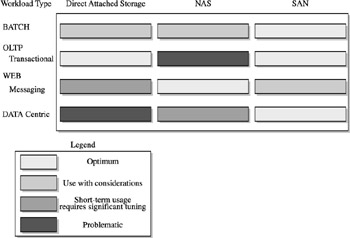Considerations for IO Workloads in Storage Networking
| |
Considerations for I/O Workloads in Storage Networking
Implementing a solution that meets a set of business applications requires a workload analysis, as we have demonstrated. It then becomes necessary to analyze an existing configuration or develop a new configuration that can sustain the workload and meet user service levels. However, in the world of storage networking, IT faces additional challenges. These issues focus on the increasing separation from the server complex, something which becomes an infrastructure in and of itself (such as a storage network infrastructure).
The most visible issue will be the discrete activities necessary to analyze the I/O infrastructure. Even though it must be taken in context with the business application and subsequent workload analysis, I/O becomes its own entity when moved into a storage networking model. Therefore, it is imperative to plan, model, and configure storage networking solutions with sufficient detail and I/O specifics that are consistent with the workloads you are supporting.
In some cases, the I/O workload is only part of a larger capacity planning exercise. Consequently, I/O workload planning needs to become integrated into existing planning activities and be driven from workload estimates that have been previously discovered. If that is the case, the minimum elements of I/O workload planning, as indicated in the earlier section Deposit ApplicationWorkload Attributes, are still required and should be discovered even though they may come from an existing capacity planning exercise.
The ability to support multiple workload types cannot be overlooked. This will probably be the most challenging activity required. Certainly SANs and, in some cases, NAS solutions will be required to support workloads that are disparate in their characteristics and processing service levels. This makes workload analysis imperative when planning the I/O infrastructure so workloads can be identified and sized before implementation takes place. This is also necessary in order to defend existing configurations when planning upgrade strategies.
This leads us to the next two chapters in this part of the book, which concern the application of storage networking solutions and technologies. Given that we have already identified, described, and characterized our workloads at a macro level, the right solution should become evident.
SAN or NAS Solutions
With current information, you can decide pretty early whether youre looking to leverage an IP-based NAS solution or a more comprehensive FC SAN configuration. The decisions based upon workload analysis will provide accurate direction when it comes to choosing a storage networking solution. Keep in mind, it will also provide accurate justification if staying with current direct-attached storage solutions looks to be the best alternative. Figure 17-10 offers some guidelines on initial workload analysis when macro decisions need to be made regarding SAN, NAS, or direct attached.

Figure 17-10: Workload solutions matrix
| |
EAN: 2147483647
Pages: 192